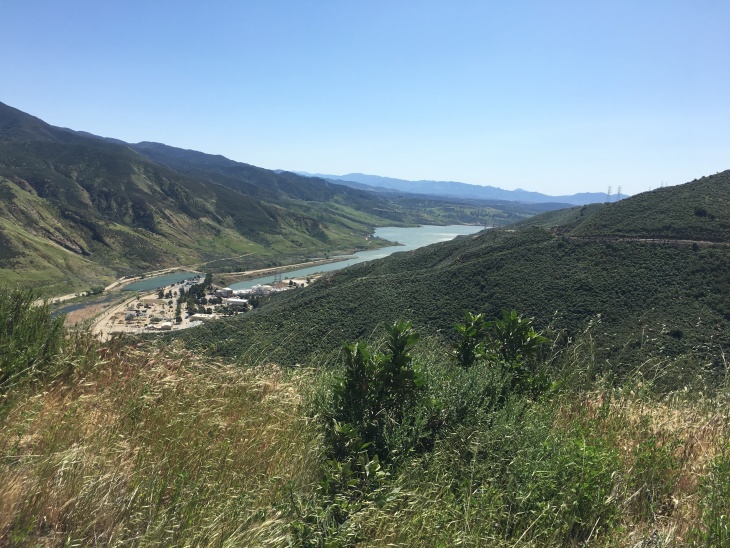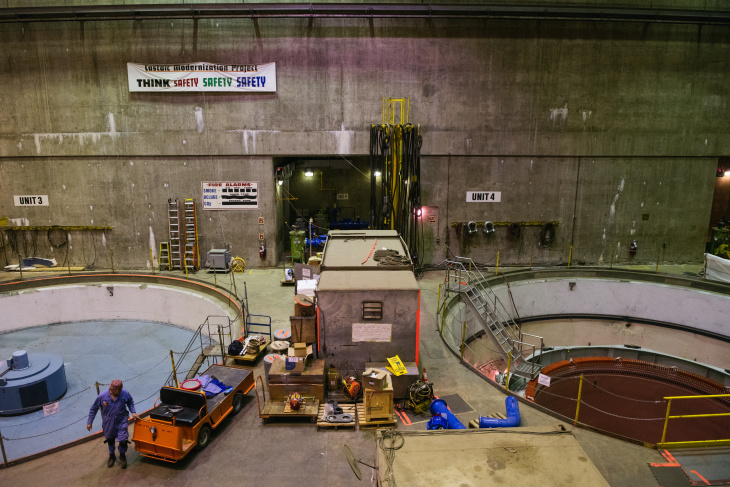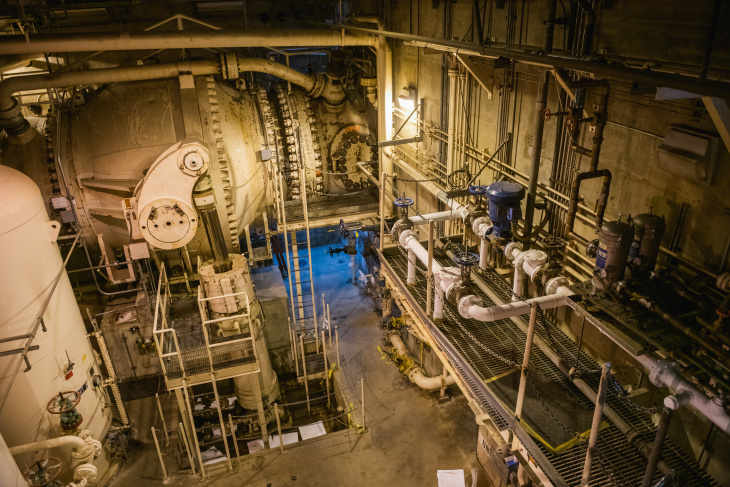How LADWP Uses Two Lakes To Store Energy Like A Giant Batter

If L.A. is going to stop burning fossil fuels by 2045 — a key goal of Mayor Eric Garcetti’s proposed Green New Deal — it must store a lot more of the excess solar and wind energy it produces during the day so it doesn’t have to rely on gas and coal energy to power the city when the sun sets and the wind dies.
There’s a growing focus on building big batteries — for example, the kind that use lithium ions. But L.A. needs energy storage that is far bigger than any traditional battery.
And it’s found one.
The Los Angeles Department of Water and Power has turned two big lakes into a monster battery capable of storing enough energy to power tens of thousands of homes.
It involves using the excess wind and solar power L.A.’s renewable energy sites produce during the day to pump water from Castaic Lake uphill 7.5 miles to Pyramid Lake. Then, late in the day, when the sun goes down and the city’s energy demand spikes, the water gets run downhill through hydroelectric generators at Castaic Lake.
The next day, the cycle starts over again. The same 10,000 acre-feet of water can recirculate over and over, getting pumped uphill during the day and coming downhill at night to power the city.
It’s called pumped storage, and the plant at Castaic is one of the largest such plants in the western United States, but maybe not for long.
LADWP is looking at building an even larger plant at Hoover Dam, so this form of energy storage, if replicated, could be a key to L.A. weaning itself off of fossil fuels.
SO LET’S TOUR THE CASTAIC PUMPED STORAGE PLANT
It’s hidden away — kind of like a superhero’s secret lair — behind locked gates at the end of a winding mountain ridge road off I-5.

Once you’re inside the gates, the first thing you notice are six gargantuan pipes that flow water from Pyramid Lake 7.5 miles down to Castaic Lake. Water is pumped back uphill in the same 30-foot-diameter pipes.
The pressure is 25 times the force of the water coming out of your home faucet.
Here’s another look at those massive pipes from a different perspective, way up on the mountain looking down at Castaic Lake.

Time to head down into the guts of the plant. We step off the elevator to a balcony overlooking a giant windowless chamber four stories tall.
The six turbines are in a vast windowless chamber. The pressure of the water coming downhill in the giant pipes spins the hydroelectric turbines, generating power for Los Angeles. More than 50 LADWP employees keep the plant running.
Below you can see two of the six turbine units. Unit 3 on the left, is covered and is ready to produce electricity as water spins the turbines inside it. Unit 4, on the right, is open for maintenance.

The six turbine units look like giant spools sunk into the floor. They put out enough energy, when they are all spinning, to power 83,000 homes over the course of a day. Their output is huge in comparison to LADWP’s largest chemical battery, which is a 20 megawatt lithium ion battery, which can power about 600 homes over a day.
Here is a view of the turbine in Unit 5. It’s been lifted partially above the floor of the turbine room. Each turbine weighs 550 tons. To lift them up takes two cranes that move the length of the room.

It takes a lot of pipes and plumbing to control the flow of water in this pumped storage plant. We descend several flights of stairs to get to the bottom of the plant to see the pumps.
At the very bottom of the plant, we’re 90 feet under the water level of the lake.

The pumps are what makes this plant different from an ordinary hydroelectric plant. There are six giant pumps — each with a shiny silver piston arm. They are pushing water back up the mountain to Pyramid Lake in the same 30-foot-diameter pipes that brought it down to Castaic Lake.
Recirculating the water like this takes a lot of energy — but that’s okay. DWP has more wind and solar energy during the day than it can use. So rather than disconnect the solar panels and windmills, or sell the energy cheaply to someone else, DWP uses the extra energy to move the water uphill to Pyramid Lake.
Once the water is waiting uphill at Pyramid Lake, it’s stored energy, ready to flow back downhill to generate energy when L.A. needs it, late in the day.

This battery-like combination — pumps and turbines — can be built very big. And they use the most reliable force on Earth — gravity.
Elderberry Forebay is a section of Castaic Lake that holds the water that gets recirculated between Pyramid Lake and Castaic to produce electricity.

Assistant general manager Reiko Kerr says they could pump water from Lake Mohave 20-some miles upstream to Lake Mead to run through Hoover Dam’s giant hydroelectric turbines.
“You already have the dam, you have the generators, you have the transmission lines — you basically need a set of pumps and pipelines,” Kerr said.
The eventual size depends on the number of other agencies that might invest in the project.
“That upper reservoir is huge — Lake Mead — so you could store power in the form of water up there for potentially months, and seasonally,” she said.
The Hoover Dam pumped storage project could come online by 2030, adding to the energy storage L.A. needs to get to 100 percent renewable energy.
This story is part of Elemental: Covering Sustainability, a multimedia collaboration between Cronkite News, Arizona PBS, KJZZ, KPCC, Rocky Mountain PBS and PBS SoCal.
